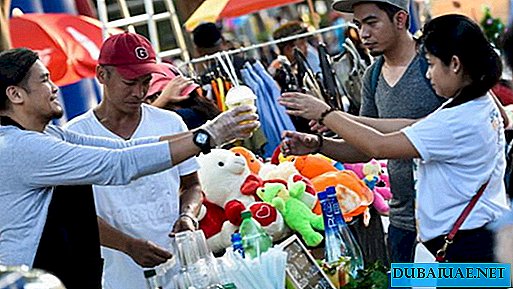We invite all the guys
For a walk in the zoo.
Come soon
Look at the beasts.
You are invited to visit:
Maple, birch, willow, pond,
Birds, predators, elephants,
Monkeys, wild boars,
Baby pink flamingo,
Wild dingo dog
Fish, wolf, bears, hedgehog ...
In general, you can’t tell everyone.
Having many years of travel experience in the UAE and almost three years of local life, I was ashamed to admit that for the first time I visited the Al Ain Zoo and the wildlife park in Sharjah only this spring. All these years she was content with herself and entertained her son with visits to a small but cozy Dubai zoo in Jumeirah, where there is a funny dwarf hippo, black and shiny like a leather sofa, long-necked giraffes looking directly at the Jumeirah villas, the Amur tiger taking water procedures in the pool, in order to escape from the heat, small timid antelopes and gazelles, ready to tear away and rush off into the corral from any harsh sound or movement ... The usual, in our understanding, zoo, only it’s very a pity for “imported” animals, not vykshih the Arabian znoyu and languishing from the hot sun: they are trying to alleviate their situation, to escape in the pool water and substituting the muzzle at spaced around the enclosures, fans. The territory of the Dubai Zoo is green and shady, so visitors can hide from the scorching rays, and the inhabitants do not hide in the "houses", but show themselves in all its glory.
My son cherished the dream of long cognitive trips and pestering me with questions about the zoos of other emirates and, as it turned out, he dreamed of getting there for nothing. The wildlife park Wild Life in Sharjah includes a whole complex aimed at understanding the canons of natural science. Moving along the main highway of Sharjah, leading in the direction of "Sharjah International Airport", the main thing is not to slip past the desired bridge, because road signs to Wild Life Park simply do not exist in nature. But it’s not difficult to navigate - on each bridge crossing the autobahn, the number of the road junction is indicated. After the eighth such bridge, you need to take the far right lane and at the junction number nine go down to the right. Amid the monotonous landscape of the white sands of Sharjah, the weary eyes of travelers reveal the splendor of a green oasis - this is the place you are looking for!

The entrance to the territory of the complex is crowned by an Arabic-style arch, in the bowels of which a gracious ticket holder issues a 15-dirham card to an adult visitor, passes the child free of charge and points to the classic fork in three roads: “Go left - you will go to the Museum of Nature, right you will go - you will go to the Children's Farm , you’ll go straight - you’ll get into Wild Life! " Guided by the idea that we need to start with the main thing, we unanimously decided to start with an examination of the Wild Life pavilion, all the more that we were curious: how is it possible - animals do not sit in cages, but coexist peacefully in conditions as close to natural as possible, while people on the contrary, they are isolated from animals by glass and concrete and are indoors.
Having parked in the parking lot, we enter the hall of the Wild Life park. The first surprise lies in wait right near the information desk - the girl in black abaya, checking the tickets, is interested in the availability of photos and video equipment. It does not make sense to unlock, the camera hangs on my chest. What can you do is not allowed! Though annoying, it was necessary to hand over for temporary storage. Later, while watching the exposition, I was constantly pursued by an obsessive thought: “Ah, what a great shot you could have taken if you had managed to get the camera inside!” The embodied idea of the created park turned out to be so unusual, amazing and simple at the same time that it caused endless delight and a feeling of gratitude to all the people involved in this project. The systematics of the exposition is scientifically classified: visitors are met by the permanent inhabitants of the Arabian Peninsula - sand turtles, snakes, lizards and other reptiles; the inhabitants of coastal waters are frogs, sea turtles and snakes, as well as ubiquitous insects. Behind the glass that separates the worlds of small guests of deserts and foothills, fluffy lumps of rodents lead their unpretentious lifestyle. A sticker with a picture of a funny animal and a warning inscription flaunts near the information signs: “Do not knock on the glass, I am nervous and stress-prone!”, But in real life the life of these pretty puffies is constantly in a stressful situation - feathered predators hunt them and creeping reptiles.
Premises with winding transitions smoothly flow into each other, revealing the rich diversity of wildlife. But behind a dense heavy curtain of thick rope ropes is the territory representing a corner of the emirate foothills. Visitors are in a kind of “winter garden”: the “mountain river” quietly carries its flowing waters, along which different types of birds nest, in the “rocky cliffs” round-winged swallows set up round houses, small predators — raccoons — conduct round-the-clock farming. ferrets, martens. More "serious" predators are closed away from sin by a glass partition, but I would like to think that at night, when the park is already closed and visitors have long gone home, badgers, foxes and caracals let out hunt for vigorous, frightened birds that have lost their vigilance.

Following the "winter garden" in a dark cave is a flock of eerie cave-winged bats. They rush about under the gloomy arches of their cold house, clinging on the fly to fruits hanging on dry branches. Dive like black "Messers", miraculously not colliding on the fly, and freeze, hanging upside down. And finally, the main inspection begins - birds, antelopes, mountain goats, hyenoid dogs, jackals, wolves, leopards and monkeys peacefully coexist on a gigantic territory. Looking at this social idyll, I involuntarily want to exclaim: "This is impossible!" In reality, everything is not as romantic as it was originally seen: the habitats of predators, herbivores and primates are reliably fenced by wide ditches, protected by barbed wire, invisible at first sight.
In the cafe of the wildlife park you can take a break, have a glass of cool freshly squeezed juice, eat sandwiches while watching the panorama of the rich diversity of the fauna of Arabia unfolding outside the window. Having replenished the reserves of forces and energy, we go straight on to the Museum of Nature.
The main idea of creating this museum is to convey to visitors the idea of how important it is for the "crown of creation" and the "king of nature" to take care and protect the fragile world, to protect everything that surrounds us and think about the future. Like a silent reproach and a reminder of the unsteadiness of being - a stone from Hiroshima, which experienced the horror of a nuclear bombardment and its consequences, next to another messenger of heaven is a fragment of a cosmic meteorite. Museum exhibits tell about life on Earth literally from the day of the creation of the world, illustrating dry facts with dynamic short films. It would be very useful and informative to arrange natural science lessons for schoolchildren in this wonderful place.
Finally, it remains to visit the Children's Farm. However, if you arrived here with children of preschool or primary school age, then from the Children's Farm you should start an examination: the child’s direct contact with animals causes genuine joy and complacency. It’s very good when theoretically the baby already knows about the device of the “artificial hen” - an incubator, but when he sees with his own eyes how pecks appear on tiny spotted testicles, and after a while a wet and defenseless quail hatch from a cracked shell, he never he will forget and still think very hard whether he will need a slingshot to hunt such touching birds. And then he will see how great it is that feeding and petting animals, as well as riding a pony, is allowed!

The trip around the Wild Life complex took us almost 4 hours, we were full of impressions and desires to return here more than once. But according to plans the next weekend we were waiting for the zoo in Al Ain.
The story of Al-Ain itself - the birthplace of the first president of the UAE, Sheikh Zayed, the cozy green "summer village" of the Emirate of Abu Dhabi - will surely sound the story next time, and today ... We arrived at al-Ain Zoo!
The first thought that came to mind was: "It’s good that the sultry strangling summer has not come yet!" Indeed, the vast territory of the zoo involves long transitions in the open air, so you should take care in advance about hats, sunglasses and soft drinks for all participants in the event. However, it does not matter if all the equipment is forgotten at home: under the dome of the composition that precedes the zoo, there are numerous shops with all the necessary details. One more piece of advice for visitors: do not rush to get rid of entrance tickets right at the entrance to Zoo, because they are boarding passes for a train rolling passengers along the aviaries of the “old” zoo, while only two people will have to move around the territory of the “new” one. You ask, why present a ticket on a steam locomotive, if it is already clear that since you have entered the park, do you have a ticket? And then I’ll answer that the train conductor will immediately pick up your ticket so that you can ride only once per visit. The locomotive walk allows you to decide: where to start, in which direction to go first, in which direction - to continue the inspection. In the “old” zoo, huge elephant turtles tirelessly dig trenches and trenches with their powerful clawed paws, which makes the turtle enclosure look like a war zone: here and there, fountains of sand and dust soar into the air, as if from shells.
Amazing artiodactyls - giraffes. Because of the long neck, which is about 4/3 of the length of the body, the giraffe has the highest pressure of all known animals. It is almost 3 times higher than human blood pressure. Both male and female giraffes have horns, and the giraffe is the only animal that is already born with horns. There is only one kind of giraffe in nature, but the body color varies greatly: beige background and dark brown spots or brown background and pale yellow triangular or hexagonal spots. Males are darker than females and young animals.
A curious sight is lunch at the hippos. A herd of glossy carcasses, like huge vegetable processing machines, draws tens of kilograms of cabbage, carrots, pumpkins, eggplants, loudly making champing, squishy, sucking sounds, and then, dragging its belly bags on the ground, hardly moves to the water. The skin of hippos is equipped with glands that protect it from drying out. The secret of these glands has a reddish color and is liberated liberally when the animal overheats or dries, so from afar it seems that the hippos rusted from water and the sun. It remains a mystery how these colossals, frozen in their evolutionary development many years ago, have not died out yet.

The "new" part of the zoo compares favorably with its design and composition. Dangerous wild animals live at an unattainable distance and are reliably protected from stupid human tricks, but are perfectly visible from different directions. Herbivorous roe deer, gazelles, chamois, oryxes, saber-horn antelopes, whose horns are bent back by a wide arc resembling a Turkish scimitar, freely run across the hilly green pens, which have a warning for amateur photographers: "Do not shoot with a flash!" So as not to frighten the animals. An interesting fact: it turns out that small oribi antelopes do not have sweat glands, so they can live in places where there is not a drop of water, being content with water from the grass and that meager dew that falls at dawn.
The terrarium of the al-Ain zoo simply amazes the imagination of any visitor. I have never seen such a snake collection. The three-colored handsome python recalled the famous fairy tale of Rudyard Kipling; a muscular boa, lazily digesting food, squinted at the dim lights; quickly zigzagging along the sand, rustling poisonous gyurza and vipers rustled. The pigeon-colored varanchiki, satiated basking under an artificial sun, did not at all produce the appearance of serious hunters. Colored sea turtles densely settled on pebbles, exhibiting their periscope heads.
A lot of interesting things for adults and children are fraught with the world of wildlife. The only thing that I had to regret was the aquarium, which we had heard about, and which was closed for reconstruction, and the timing of its opening in an updated form is not known to anyone. Many aviaries in the zoo are empty and are looking forward to their new settlers, and on the inhabited aviaries an information plate can not always be found. I'd like to believe that by our next visit we will not find any shortcomings.
Elena Balina








